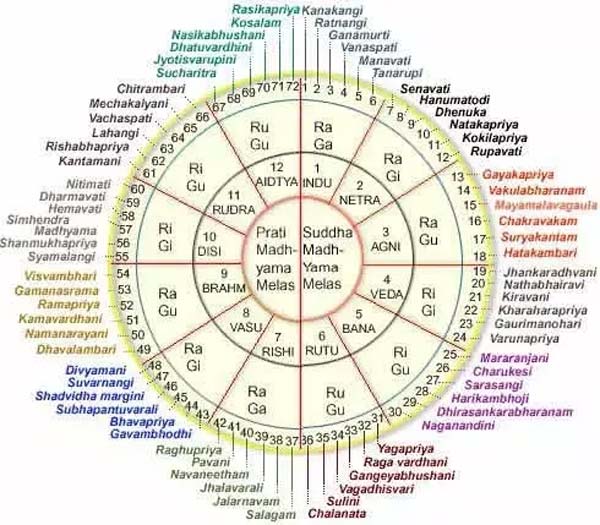“A raga is a melody bejewelled with notes and emotions that colours and delights the mind” – Sage Matanga
In our previous article we understood the importance of raga in Indian classical music.
We shall now delve a little into the basic classification of ragas. It will enable us to understand and appreciate the matrix of ragas and their related music compositions.
Seven Swaras and Dwadasa Swarasthanas
In the introduction, we learnt about the evolution of the basic seven swaras, sa, ri, ga, ma pa, dha, ni . Sa and Pa are known as Jeeva swaras and they have only single identifying frequency. The five other swaras, Ri, Ga, Ma, Da, Ni are associated with one more frequency each, and all of them together create 12 swaras, known as Dwadasa swarasthanas.
1 Shadjam – Sa
2 Suddha Rishabam – Ra, Small Ri
3 Chatusruthi Rishabam – Ri, Big Ri
4 Sadharana Gandharam – Gi, Small Ga
5 Anthara Gandharam – Gu, Big Ga
6 Suddha Madhyamam – Ma, Small Ma
7 Prati Madhyamam – Mi, Big Ma
8 Panchamam – Pa
9 Suddha Dhaivatham – Da, Small Da
10 Chatusruthi Dhaivatham – Di, Big Da
11 Kaisika Nishadham – Ni, Small Ni
12 Kakali Nishadham – Nu, Big Ni
Ragas are created using different combinations of these swaras.
As a generation who grew up listening to Suprabhatam on the radio early in the morning, ragas like Kanakangi, Ratnangi, Kharaharapriya, Kalyani, Dhenuka, Natabhairvi, and Vakulabharanam are familiar names.
Also Read: Raga: the soul of Indian Classical music
Srinivasa Gadyam, written as an invocation of Lord Venkateswara mentions the names of various Janaka ragas and Janya Ragas.
72 Melakarta ragas
Although ragas were prevalent since ancient times, it took considerable time for musicologists and scholars to research, identify, and classify them.
A detailed classification of ragas was illustrated in the monumental musical treatise, Chaturdandi Prakasika by Venkatamukhi in 1620 AD. It is considered a landmark in the realm of Carnatic classical music as it is a comprehensive and systematic formula of all swaras in ancient and modern systems of music across the globe. Ragas were categorised as per the arrangement of the swaras in an ascending and descending order, or arohana and avarohana. The immaculate Melakarta classification system of ragas has withstood the test of time and is an established system that has undergone minimal modifications over the years and is in use even today.
In this meticulous scheme, the Melakartas are framed out of a systematic permutation of the seven swaras into twelve swara sthanas. Venkatamukhi was assertive of his work when claimed that Lord Shiva could not have created more Melakartas!
Basic classification
Melakarta ragas contain all seven swaras, and are known as Sampoorna ragas. Imperatively, the first 36 ragas in the 72 Melakarta raga scheme have sudha madhyamam or small Ma in their arohana (ascending order) and avarohana (descending order). The remaining 36 ragas comprise of prati madhyamam or big Ma in their scale.
Also Read : Understanding Music
Chakras
These 72 ragas were further divided into 12 groups based on swara sthanas, and are designated with a chakra. Each chakra is encompassed with 6 Melakarta ragas; The names of the chakras correspond to their number, in an ascending order.
1st Chakra – Indu
2nd Chakra – Netra
3rd Chakra – Agni
4th Chakra – Veda
5th Chakra – Bana
6th Chakra – Ruthu
7th Chakra – Rishi
8th Chakra – Vasu –
9th Chakra – Brahma
10th Chakra – Disi
11th Chakra – Rudra
12th Chakra – Aditya
All the compositions in Carnatic classical music are based on this Melakarta scheme.
Janya Ragas
The myriad ragas that originate from these 72 parent ragas are known as Janya ragas or offspring ragas which are related to the parent raga but may include swaras from different groups.
There are other sub divisions and micro divisions in the 72 Melakarta raga scheme which can be analysed for a finer understanding by devoted learners of Carnatic classical music.
The whole concept of ragas in Carnatic classical music is based on this unique, absolutely comprehensive diversification and tabulation of ragas. It has given ample scope for the innovation and creation of new ragas. Following the scheme, later composers like Tyagaraja created many beautiful ragas and compositions. Music composers who have been contributing to the vast treasure of ragas with their innovations rely on the Melakarta ragas.




